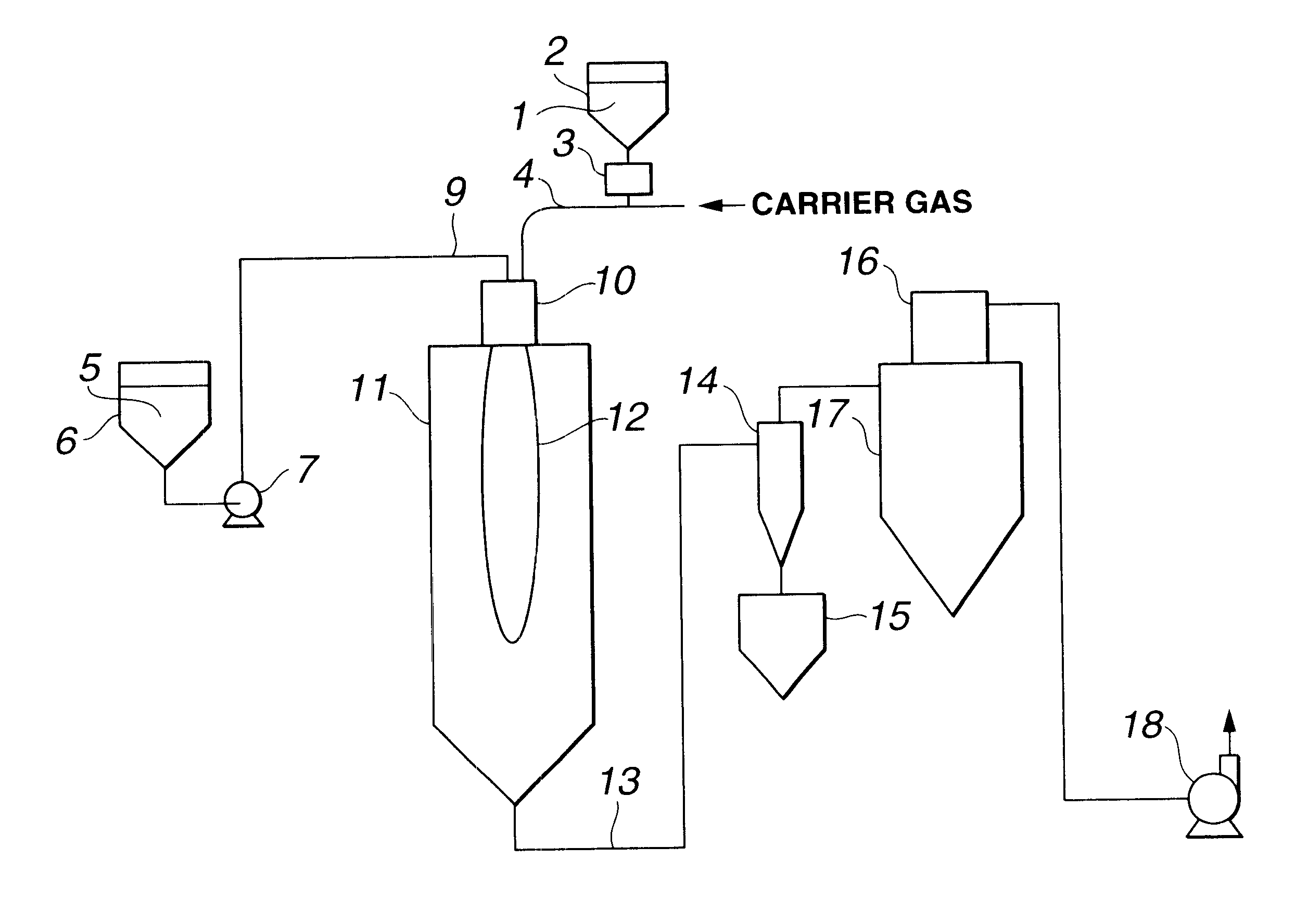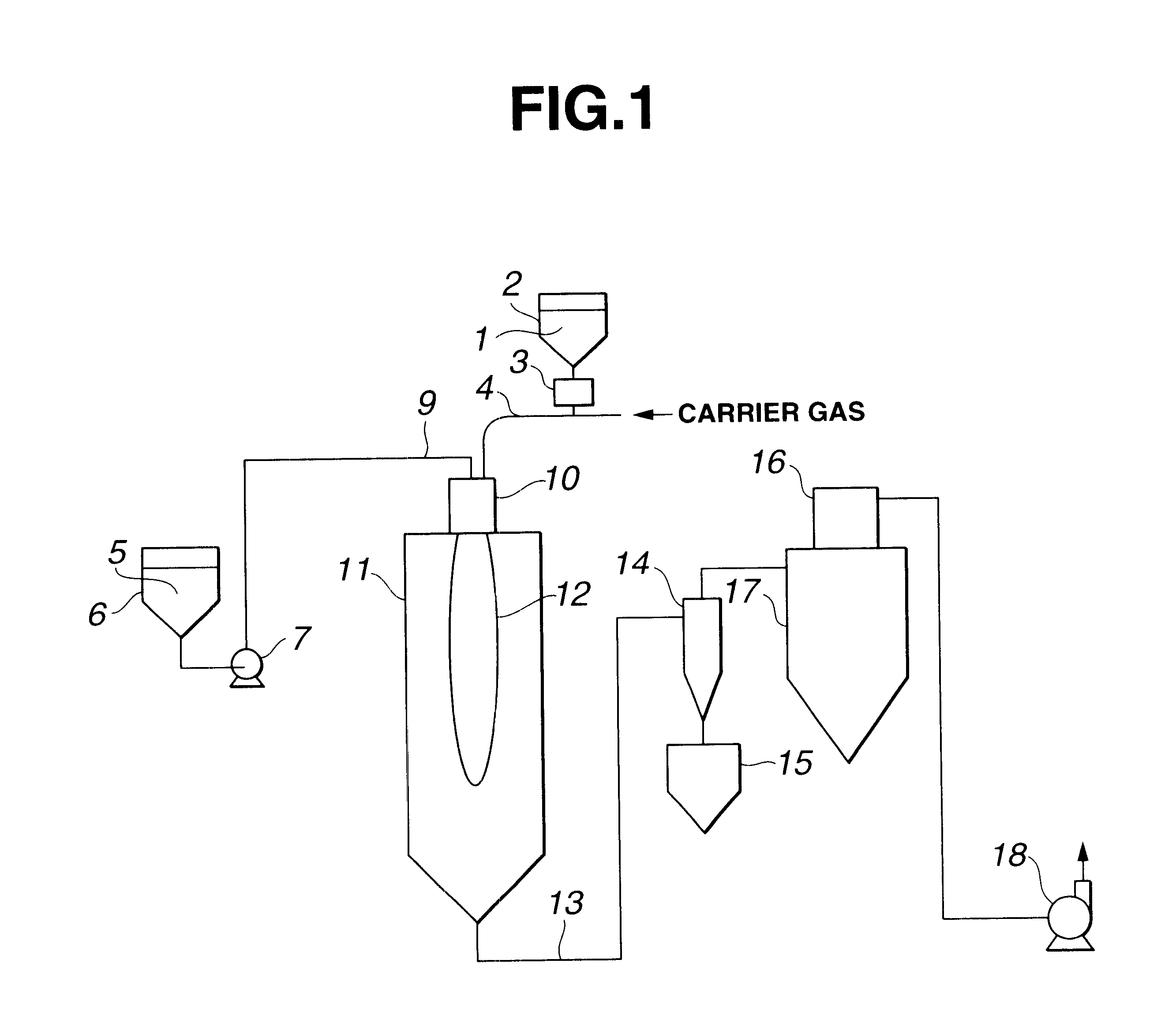Method of producing spherical silica powder
a technology of spherical silica and powder, which is applied in the direction of silicon oxides, manufacturing tools, silicon compounds, etc., can solve the problems of reducing thermal energy efficiency, melting and sphericalizing, and increasing costs
- Summary
- Abstract
- Description
- Claims
- Application Information
AI Technical Summary
Benefits of technology
Problems solved by technology
Method used
Image
Examples
example 1
A production system of the type shown in FIG. 1 was used. The combustion furnace 11 was a cylindrical stainless tube having an inside diameter of 400 mm and a height of 3,000 mm, and lined with alumina heat-insulating material. The pressure within the furnace 11 was set to a negative pressure of 0.5 kPa by evacuation with an exhaust unit 18. Propane gas and oxygen gas were fed from a burner 10 at respective rates of 0.5 Nm.sup.3 / h and 20 Nm.sup.3 / h to form a flame. Next, 20 kg / h of crystalline silica powder having an average particle size of 15 .mu.m and a purity of 99.6% was fed to the burner 10 by a metering feeder 3, and introduced to the flame through the burner 10 by dispersion and entrainment with 6 Nm.sup.3 / h of oxygen as the carrier gas. At the same time, hexamethyldisiloxane was fed at a rate of 10 kg / h by a metering pump 7, atomized by 3 Nm.sup.3 / h of air from an atomizing nozzle mounted on the burner 10, and burned in a composite flame 12 formed by combustion of the p...
example 2
A production system of the type shown in FIG. 2 was used. This system was substantially the same as that used in Example 1, except that a vaporizer was installed on the siloxane feed line. A flame was formed by feeding 0.3 Nm.sup.3 / h of propane gas and 22 Nm.sup.3 / h of oxygen gas from a burner 10. Next, crystalline silica having an average particle size of 18 .mu.m and a purity of 99.6% was fed to the burner 10 by a metering feeder 3 at a rate of 15 kg / h, and introduced to the flame through the burner 10 by dispersion and entrainment with 5 Nm.sup.3 / h of oxygen as the carrier gas. At the same time, hexamethyldisiloxane was fed at a rate of 8 kg / h by a metering pump 7, converted to superheated vapor by a vaporizer 8, mixed with 2 Nm.sup.3 / h of nitrogen gas and carried to a burner 10, where it was burned in a composite flame 12 formed by combustion of the propane gas and siloxane. The molten silica powder was cooled in a flue line 13, then recovered with collection and recovery de...
example 3
The same production system was used as in Example 1. The pressure within the furnace 11 was set to a negative pressure of 0.6 kPa by evacuation with the exhaust unit 18. Hydrogen gas and oxygen gas were fed in at respective rates of 1.5 Nm.sup.3 / h and 20 Nm.sup.3 / h to a burner 10 to form a flame. Next, 10 kg / h of crystalline silica powder having an average particle size of 20 .mu.m and a purity of 99.6% was fed to the burner 10 by a metering feeder 3, and introduced to the flame through the burner 10 by dispersion and entrainment with 6 Nm.sup.3 / h of oxygen as the carrier gas. At the same time, methyltrimethoxysilane was fed at a rate of 13 kg / h by a metering pump 7, atomized by 5 Nm.sup.3 / h of air from an atomizing nozzle mounted on the burner 10, and burned in a composite flame 12 formed by combustion of the hydrogen gas and methyltrimethoxysilane. The molten silica powder was cooled in a flue line 13, then recovered with collection and recovery devices. The recovered silica p...
PUM
| Property | Measurement | Unit |
|---|---|---|
| particle size | aaaaa | aaaaa |
| particle size | aaaaa | aaaaa |
| particle size | aaaaa | aaaaa |
Abstract
Description
Claims
Application Information
 Login to View More
Login to View More - R&D
- Intellectual Property
- Life Sciences
- Materials
- Tech Scout
- Unparalleled Data Quality
- Higher Quality Content
- 60% Fewer Hallucinations
Browse by: Latest US Patents, China's latest patents, Technical Efficacy Thesaurus, Application Domain, Technology Topic, Popular Technical Reports.
© 2025 PatSnap. All rights reserved.Legal|Privacy policy|Modern Slavery Act Transparency Statement|Sitemap|About US| Contact US: help@patsnap.com



